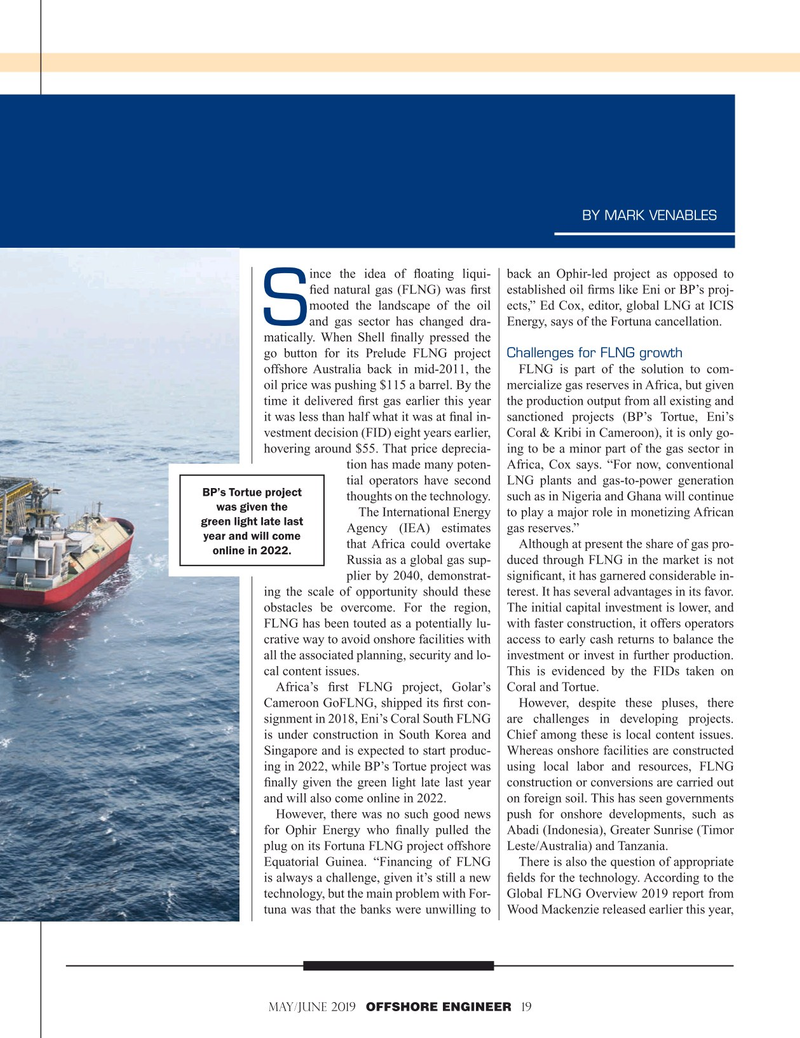
Page 19: of Offshore Engineer Magazine (May/Jun 2019)
Offshore Renewables Review
Read this page in Pdf, Flash or Html5 edition of May/Jun 2019 Offshore Engineer Magazine
BY MARK VENABLES ince the idea of ? oating liqui- back an Ophir-led project as opposed to ? ed natural gas (FLNG) was ? rst established oil ? rms like Eni or BP’s proj- mooted the landscape of the oil ects,” Ed Cox, editor, global LNG at ICIS
Sand gas sector has changed dra- Energy, says of the Fortuna cancellation.
matically. When Shell ? nally pressed the go button for its Prelude FLNG project Challenges for FLNG growth offshore Australia back in mid-2011, the FLNG is part of the solution to com- oil price was pushing $115 a barrel. By the mercialize gas reserves in Africa, but given time it delivered ? rst gas earlier this year the production output from all existing and it was less than half what it was at ? nal in- sanctioned projects (BP’s Tortue, Eni’s vestment decision (FID) eight years earlier, Coral & Kribi in Cameroon), it is only go- hovering around $55. That price deprecia- ing to be a minor part of the gas sector in tion has made many poten- Africa, Cox says. “For now, conventional tial operators have second LNG plants and gas-to-power generation
BP’s Tortue project thoughts on the technology. such as in Nigeria and Ghana will continue was given the
The International Energy to play a major role in monetizing African green light late last
Agency (IEA) estimates gas reserves.” year and will come that Africa could overtake Although at present the share of gas pro- online in 2022.
Russia as a global gas sup- duced through FLNG in the market is not plier by 2040, demonstrat- signi? cant, it has garnered considerable in- ing the scale of opportunity should these terest. It has several advantages in its favor. obstacles be overcome. For the region, The initial capital investment is lower, and
FLNG has been touted as a potentially lu- with faster construction, it offers operators crative way to avoid onshore facilities with access to early cash returns to balance the all the associated planning, security and lo- investment or invest in further production. cal content issues. This is evidenced by the FIDs taken on
Africa’s ? rst FLNG project, Golar’s Coral and Tortue.
Cameroon GoFLNG, shipped its ? rst con- However, despite these pluses, there signment in 2018, Eni’s Coral South FLNG are challenges in developing projects. is under construction in South Korea and Chief among these is local content issues.
Singapore and is expected to start produc- Whereas onshore facilities are constructed ing in 2022, while BP’s Tortue project was using local labor and resources, FLNG ? nally given the green light late last year construction or conversions are carried out and will also come online in 2022. on foreign soil. This has seen governments
However, there was no such good news push for onshore developments, such as for Ophir Energy who ? nally pulled the Abadi (Indonesia), Greater Sunrise (Timor plug on its Fortuna FLNG project offshore Leste/Australia) and Tanzania.
Equatorial Guinea. “Financing of FLNG There is also the question of appropriate is always a challenge, given it’s still a new ? elds for the technology. According to the technology, but the main problem with For- Global FLNG Overview 2019 report from tuna was that the banks were unwilling to Wood Mackenzie released earlier this year,
MaY/JUNE 2019 OFFSHORE ENGINEER 19

 18
18

 20
20